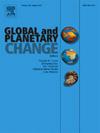Collapse of prehistoric cultures in central-eastern China linked to the El Niño-like states during the 4.2 ka event
IF 4
1区 地球科学
Q1 GEOGRAPHY, PHYSICAL
引用次数: 0
Abstract
The Huai River Basin, located in the transition zone between the Yangtze and Yellow River basins, plays a significant role in the integration and development of Neolithic cultures. Lack of precipitation reconstructions from the Huai River Basin limits our knowledge on patterns and mechanisms of precipitation in the East Asian monsoon (EAM) region during the 4.2 ka event, which also hinders our understanding of the relationship between Neolithic culture transitions and climate change. In this study, we report a pollen record from the Wufan profile in the upper Huai River Basin. Our record indicates a wetter climate condition during the 4.2 ka event, which is in contrast to the reconstructed dry conditions in northern China. We further integrated accurately dated precipitation records of the 4.2 ka event and found a significant “dry-wet-dry” precipitation pattern in the EAM region during this cooling period. Specifically, northern China was relatively dry, the Jianghuai region was relatively wet, and the southwestern region was relatively dry. This pattern was likely driven by El Niño-like conditions in the tropical Pacific. In addition, we discovered a close link between the collapse of Neolithic cultures and the increased precipitation in central-eastern China, which is likely dominated by the El Niño-like states in the tropical Pacific.
求助全文
约1分钟内获得全文
求助全文
来源期刊

Global and Planetary Change
地学天文-地球科学综合
CiteScore
7.40
自引率
10.30%
发文量
226
审稿时长
63 days
期刊介绍:
The objective of the journal Global and Planetary Change is to provide a multi-disciplinary overview of the processes taking place in the Earth System and involved in planetary change over time. The journal focuses on records of the past and current state of the earth system, and future scenarios , and their link to global environmental change. Regional or process-oriented studies are welcome if they discuss global implications. Topics include, but are not limited to, changes in the dynamics and composition of the atmosphere, oceans and cryosphere, as well as climate change, sea level variation, observations/modelling of Earth processes from deep to (near-)surface and their coupling, global ecology, biogeography and the resilience/thresholds in ecosystems.
Key criteria for the consideration of manuscripts are (a) the relevance for the global scientific community and/or (b) the wider implications for global scale problems, preferably combined with (c) having a significance beyond a single discipline. A clear focus on key processes associated with planetary scale change is strongly encouraged.
Manuscripts can be submitted as either research contributions or as a review article. Every effort should be made towards the presentation of research outcomes in an understandable way for a broad readership.
 求助内容:
求助内容: 应助结果提醒方式:
应助结果提醒方式:


